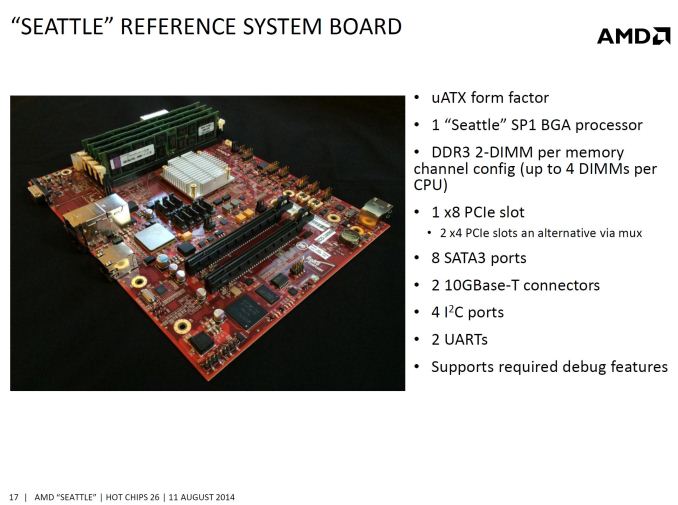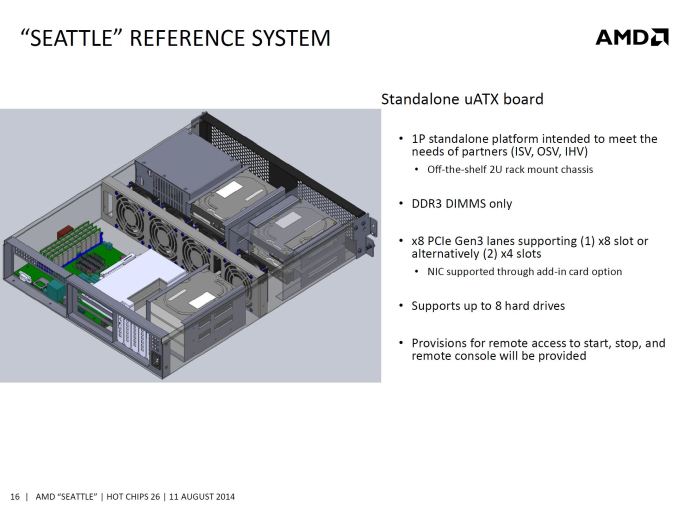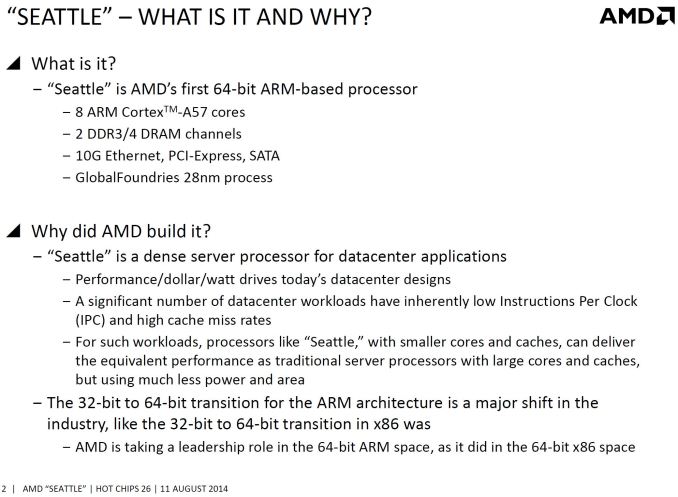AMD’s Big Bet on ARM Powered Servers: Opteron A1100 Revealed
by Stephen Barrett on August 11, 2014 12:00 PM EST- Posted in
- SoCs
- IT Computing
- AMD
- Arm
- Opteron
- server
- Enterprise CPUs
- Opteron A1100
Reference Design and Final Words
With the A1100, AMD is providing system integrators with a reference design µATX motherboard and 2U server rack. These will demonstrate SoC power delivery, IO and boot configuration, as well as SCP connectivity to integrators to utilize in their own designs.
Interestingly, despite the considerable horsepower contained inside the Opteron A1100 compared to previous non-AMD Cortex A9 server designs, AMD's reference server is clearly not specifically targeting web server applications. The reference design is not computationally dense as it only has one 8-core CPU node in a 2U chassis. The design is targeting storage servers with slots for 8 hard drives.
AMD’s presentation mentions a focus on datacenters where IO connectivity and low power consumption are more important than CPU horsepower. AMD certainly has plenty of server experience and will be well positioned to attack this market with this differentiated product. However, I could not shake the feeling AMD was missing an opportunity in micro severs by not targeting the web server application market with a more processor dense reference design. In fact, digging through our own content on the A1100, I found a quote from Anand saying “AMD sees huge demand in the memcached space, cold storage servers and Apache web front ends. The offer is pretty simple: take cost savings on the CPU front and pour it into more DRAM.” I agree with AMD, the A1100 is well suited for datacenter applications- but we only see one incarnation of that with the storage server reference design.
With the acquisition of SeaMicro adding fabric to AMDs long list of expertise, it is surprising to not see a micro server design that connects dozens of these processors together. Calxeda’s Boston Virdis server is exactly that, and our own conclusions stated that the design has huge promise if it was only a bit faster.
Perhaps it is due to excitement about this CPU that I am looking for a more innovative reference server design. All in all, that is not a bad position to be in. Perhaps it is enough to even convince micro sever companies to buy their CPU from AMD instead of designing their own. One thing is for sure, it will be interesting to watch the server market evolve over the next few years. It might not happen, but there could be a day when using your phone to post to Facebook is serviced end-to-end by ARM CPUs.













28 Comments
View All Comments
Stuka87 - Monday, August 11, 2014 - link
Unless I missed it, what process are these being made on? I would hope they are one of the 20nm processes, but maybe they are still 28nm?VulgarDisplay - Monday, August 11, 2014 - link
The article said 28nm.richricard - Monday, August 11, 2014 - link
Where...?VeauX - Monday, August 11, 2014 - link
Last page, on the AMD slides bellow the "what is it" sectiondgingeri - Monday, August 11, 2014 - link
This could be a great thing. As a systems admin, I can see the need for small, low power servers for local purposes.They'd be great for branch offices or small offices who have much of their infrastructure in the cloud or remote datacenters. Imagine spending $1000 on a local domain controller and file server branch cache with everything else remote instead of having to spend the $5000 we do today.
They'd also be great for a local departmental authentication server in a large office. Keep one as a domain controller in the wiring closet with the local switches for each physical section of the office, and it would reduce the load on the main domain controller in the datacenter, reducing equipment requirements, power consumption, and cooling costs. It would also increase redundancy of the AD domain.
There are a lot of possibilities for this thing. Virtualization has already taken care of most of the uses it could have had, but lower power servers do offer an alternative to that, too.
thesnowman - Tuesday, August 12, 2014 - link
Unless you are going to use Linux and run samba for active directory and file server duties this CPU is not suitable. Windows Server does not run on ARM (yet).iAPX - Tuesday, August 12, 2014 - link
The reference design is clearly tardeted at NAS, powerful NAS up to 8 drives, on the SOHO space. But I see an effective way to use it as Memcache server (without storage), benefitting of it's 128GB memory space with a power-effective CPU, probably 2 of them in a 1U box.There's also other possibilities, such as SSD + 8core ARM CPU, 2 of them on a 1U box, for MongoDB or CouchDB.
Beside this reference design, there's a world of possibilities, considering this SoC and it's incredible potential (when it's not CPU-hungry tasks!)
LarsBars - Monday, August 11, 2014 - link
Has Microsoft ever dropped hints about future versions of Windows Server supporting ARM? Obviously they've done Windows on ARM before (Windows RT) but I've never heard any mention of Windows Server running on these new AMD ARM CPUs.LarsBars - Monday, August 11, 2014 - link
Okay, I probably should have looked it up first: http://www.pcworld.com/article/2092620/microsoft-j...I'm guessing a big blocker to Windows Server on ARM would be getting people to convert server workloads to run on ARM that currently run on x64. But I could actually see one potential usage for Windows Server ARM: storage spaces. If Windows Server 2012 R2 (or vNext) gets developed for ARM, we could see ARM-based Windows Server storage devices serving up SAN-competitive iSCSI and SMB storage, at a greatly reduced cost.
someone0 - Monday, August 11, 2014 - link
Maybe, it's all depend on what the market wants. If people want enough servers on ARM, there will eventually be Windows server for ARM. and may even be based on RT. If you remember Windows for IA-64, that will tell you how much MS willing to bang its server OS off the x86 codes. If not linux will steal all the markets. OS for server is a different beast, most servers don't need to run the usual x86 and usual win32/64 based applications.